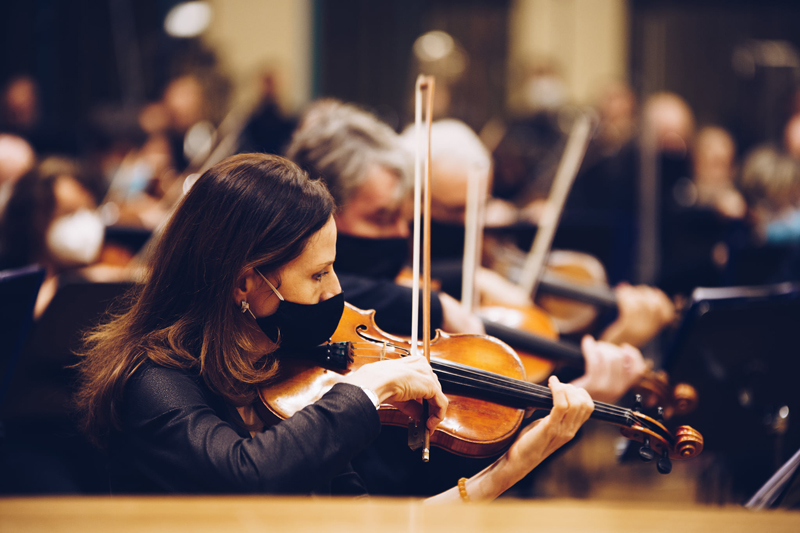LENKA DOHNALOVÁ
During the coronavirus pandemic, debates emerged about how state funding for the arts, a prevalent model in Europe, helped or hindered arts organizations during the time of lockdown. In this overview, Lenka Dohnalová surveys the past year in Czech orchestras, and provides us with a look into how a particular model of arts funding fares under pandemic stress.
The novel coronavirus pandemic had a catastrophic effect on cultural institutions around the world. Concerts were cancelled or moved online, music and theatre companies lost significant revenue from ticket sales, and everyone had to adapt to last-minute cancellations. How did Czech orchestras fare in this crisis?
The Czech Republic is home to a dense network of professional symphonic orchestras, most subsidized by municipalities, some by counties. A large part of them (excluding The Czech Philharmonic Orchestra, FOK, SOČR, and some of those founded after 1989, like ČNSO) are also regularly financed by the so-called Professional Theatre, Symphonic Orchestra, and Choir State Finance Program (Program státní podpory profesionálních divadel, symfonických orchestrů a pěveckých sborů), introduced in the Resolution of the Government from the year 2003 n.902. In 2020 it amounted to 55 million crowns for the 13 companies that met the criteria of the program, heavily supplemented by the resources from the 2020 Aid Package (38 million) that was meant to preserve work positions even while companies’ activity stalled. Some of the smaller chamber choirs receive aid for year-round activity from the basic grant program (for instance the Berg orchestra).
During a normal season, the financial self-sufficiency of our orchestras is around 20%, if we don’t include the bottom lines at the end of the season. Orchestras without a trustee or a founder reach the highest level of self-sufficiency, at about 60-70%. The downfall caused by the Covid-19 pandemic in 2020 reduced the percentage of self-sufficiency by an average of about half. The extent of the downfall depended on the orchestras’ organizational structure: the orchestras without a trustee, like the PKF (Prague Philharmonic,) the Czech Philharmonic Choir, the orchestra Berg and otherswere impacted the most. Luck also played a role; some were lucky enough to have had their projects planned for the short period of lifted lockdown at the beginning of the year and into September.
Owning a venue, previously an advantage as well as source of side-revenue from subletting, became a financial burden for cultural institutions and another source of lost revenue. On the other hand, orchestras that rented their spaces, oftentimes with a larger amount of outsourced talent, saved on operations. Of course, like everyone else, their main revenue decreased while their expenses for new performance methods (streaming, unconventional open air events) and hygiene measures (not just masks, covid tests and disinfectant but also performance space alterations, energy expenses, personnel etc.) increased. Money was also being put into recording technology and software, as well as towards partnerships with recording companies (Parma Recordings, Arco Diva, NAXOS and others), although this could be considered more of an investment.
In almost all cases, trustees and founders (municipalities, regions, the state) did not defund cultural institutions and some actually raised the subsidies slightly, evidently because of the state mandate to raise wages (though Brno lowered them.) Raising funding also had to do with municipalities receiving tax compensation for lost income, through an exceptional non-purpose subsidy that was provided by the state to the counties. The point is that this state of limited activity on the part of orchestras can’t go on for long, as it is not sustainable. So-called “pilot” events –like the Czech Philharmonic’s concert on the 10th of May with mandatory PCR tests for the audience, and a few of the Prague Spring festival’s concerts – and the loosening of restrictions planned by the Ministry of Culture for May 17th, do not provide a long-term solution to the issue, because it is unrealistic for audiences to continue to cover the costs of PCR tests (about 1500 CZK per person) along with the price of tickets, and nor is it realistic for event organizers or the state to do so.
Although the total sum of the state-run aid program has risen to 93 million CZK for music organizations (and expected to rise to 160 million in 2021), and although such aid is definitely a significant tool in keeping the industry afloat, the final check will still fall to the trustees and founders (i.e. the regions and municipalities). The restrictions also shined a light upon the fragile existence of artists in companies that don’t offer stable employment positions, even though artists do continue to opt to be freelancers by choice. On the other hand, the situation did allow orchestras greater flexibility and creativity. Companies entered the pandemic with different resources at their disposal, but all gained new experiences and knowledge that could prove useful even after all restrictions lift.
Practically all the companies streamed concerts that they then (if copyright laws allowed) left up in their archives, because direct viewing of live performances online tended to be low – in the tens of viewers – even for orchestras. But during the next day, the views climbed to around 500 on average, although only the uploader has knowledge of how long such viewers actually spent viewing the concert. Views on Facebook tend to be much higher, but audio continuity is worse and watch times tend to be lower.
The Czech national TV station (Česká televise), the Czech radio (Český rozhlas) and TV Noe showed higher interest in partnerships – Česká televize often broadcasted concerts from the Czech Philharmonic or concerts of Janáček philharmonic in Ostrava (Stíny v mlze – Shadows in the Fog in September 2020 and Vánoční koledy v obýváku – Christmas Carols in the Living Room with A. Plachetka, K. Kněžíková, T. Klus and the Geisler sistersin December). The Czech Radio broadcast Beethoven’s Kristus na hoře Olivetské – Christ Upon the Mount of Olives with the Czech Philharmonic Choir and Kateřina Kněžíková to start off the Svatováclavský Festival with a live audience or a recital of Lukáš Vondráček. The Janáček Brno festival was successfully launched in collaboration with ČT Art before the lockdown, producing a production of the opera Osud (Destiny, L. Janáček) directed by Robert Carsen at the Janáček Theatre and filming the oratorio Lenore by A. Rejcha for the composer’s 250th anniversary. These are just a few examples. This trend of broadcast productions continues into 2021.
In conclusion, all orchestras, without exception, began to stream or initiated partnerships with recording studios – for instance, The Janáček Philharmonic in Ostrava and the Moravian Philharmonic in Olomouc partnered with The University of Silesia and Parma Recordings. Not long ago, recordings with 5-13 cameras would have been unimaginable, though now they have become the norm, though sound quality (often due to the acoustics of an empty auditorium) and directing vary.
This was how a large part of the planned performances were realized in the 2020 season, although often altered to feature different repertoire so as to cut the number of performers or with altered seating. Programmers often reached for chamber arrangements, which clearly point the way for a future practice (as a side note: I remember an exceptional chamber variation of the orchestral score of Dvořák’s Rusalka by Mariam Lejava from 2014 that sounded amazing in the small space of a Swiss theatre.) Although streamed concerts did sometimes have entry fees, they were often voluntary, and the concerts were accessible for free as well and therefore unable to compensate losses from ticket sales.
The majority of orchestras also began organizing more open-air events, oftentimes in places and formats they had never tried before – for example, on September 11th, the South Bohemian Philharmonic, with the aid of the region and municipality, put together a concert to express their gratitude to healthcare workers on the Přemysl Otakar II square in České Buďejovice. the Chamber Philharmonic of Pardubice started up a new project called From the Philharmonic to the Seniors (Filharmonie seniorům), with performances under the windows of quarantined senior homes, and in gardens and atriums (recorded by The Czech Radio and Television), For the first time ever, the Chamber Philharmonic of Pardubice endeavored in an awareness campaign, in which members of the orchestra played chamber music in public outdoors spaces – the project was called Philharmonic Open (Filharmonie Open). The project managed to generate increased media interest in the orchestra. The Carlsbad Symphonic Orchestra organized concerts for senior citizens and in poor housing projects (Novosvěstká – From The New World, A. Dvořák). The South Bohemian Symphonic Orchestra toured the country playing concerts in senior homes, clinics for the terminally ill, and social care facilities and winning plenty acclaim.
The above examples indicate that many companies acquired the broader interest of the public by organizing unusual activities, in the case of streams and recordings also generating interest abroad, thus gaining a certain degree of “social capital.” This is a trend taking place all around the world.
Many recordings of streamed event stay on file for possible later use (unless rights get in the way.) Studio and CD recordings have also risen in quantity. For instance, the Pardubice and Ostrava orchestras both released a CD in collaboration with NAXOS. Another example: The Janáček Philharmonic recorded both of D. Shostakovich’s piano concertos for the Czech Radio, P. Glass’ Violin Concerto No.2 for the Estile Publishing House, the concert version of Tristan und Isolde for Navona Records and Z. Fibich’s Symphony No.2 for NAXOS. The Plzeň Philharmonic recorded a concert of the contemporary pieces of S. Vetché, T. Ille and S. Hořínek for the Czech Radio. The Hradec Králové Philharmonic recorded Eben’s Gregorian Symphony for the radio, a CD of Bach’s piano concertos, and works by Z. Matějů and O. Kukal, and that’s just a scratching the surface.
The by now traditional and numerous programs for children were cancelled basically across the board but, even so, there were ways to get around it. For instance, the Plzeň Philharmonic retained one of their projects for pre- and elementary schools Namaluj hudbu -Draw Music, the Brno Philharmonic set up a new teaching position for comprehensive educational programs even in online format, The Carlsbad Symphonic Orchestra prepared 5 fun video-fairytales that introduce children to various musical instruments and that could later be used for musical education classes in schools.
It is now May 2021 and, unfortunately, concert dates keep being postponed to the second half of the year. Orchestras have gained competencies from past experience and the current financial situation is under control even though covid regulations don’t help and will continue to be problematic. Let us hope then, that the situation will get back to the real norm – unconditionally.




